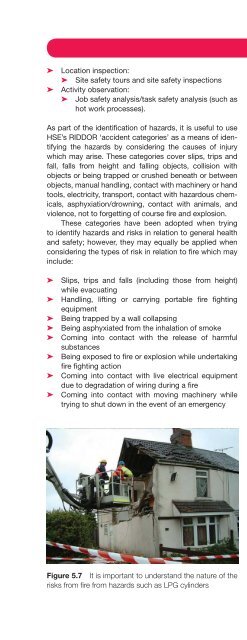Introduction to Fire Safety Management
Introduction to Fire Safety Management
Introduction to Fire Safety Management
You also want an ePaper? Increase the reach of your titles
YUMPU automatically turns print PDFs into web optimized ePapers that Google loves.
➤ Location inspection:<br />
➤ Site safety <strong>to</strong>urs and site safety inspections<br />
➤ Activity observation:<br />
➤ Job safety analysis/task safety analysis (such as<br />
hot work processes).<br />
As part of the identifi cation of hazards, it is useful <strong>to</strong> use<br />
HSE’s RIDDOR ‘accident categories’ as a means of identifying<br />
the hazards by considering the causes of injury<br />
which may arise. These categories cover slips, trips and<br />
fall, falls from height and falling objects, collision with<br />
objects or being trapped or crushed beneath or between<br />
objects, manual handling, contact with machinery or hand<br />
<strong>to</strong>ols, electricity, transport, contact with hazardous chemicals,<br />
asphyxiation/drowning, contact with animals, and<br />
violence, not <strong>to</strong> forgetting of course fi re and explosion.<br />
These categories have been adopted when trying<br />
<strong>to</strong> identify hazards and risks in relation <strong>to</strong> general health<br />
and safety; however, they may equally be applied when<br />
considering the types of risk in relation <strong>to</strong> fi re which may<br />
include:<br />
➤ Slips, trips and falls (including those from height)<br />
while evacuating<br />
➤ Handling, lifting or carrying portable fi re fi ghting<br />
equipment<br />
➤ Being trapped by a wall collapsing<br />
➤ Being asphyxiated from the inhalation of smoke<br />
➤ Coming in<strong>to</strong> contact with the release of harmful<br />
substances<br />
➤ Being exposed <strong>to</strong> fi re or explosion while undertaking<br />
fi re fi ghting action<br />
➤ Coming in<strong>to</strong> contact with live electrical equipment<br />
due <strong>to</strong> degradation of wiring during a fi re<br />
➤ Coming in<strong>to</strong> contact with moving machinery while<br />
trying <strong>to</strong> shut down in the event of an emergency<br />
Principles of risk assessment<br />
➤ Being struck by a moving vehicle while evacuating<br />
➤ Being assaulted by a person panicking in the event<br />
of a fi re.<br />
It is likely that the above list will not necessarily be<br />
included in a fi re risk assessment (see later in the module);<br />
however, each should be considered as part of a<br />
general risk assessment.<br />
In the same way, categories of health risk, i.e.<br />
chemical, biological, physical, physiological, must also<br />
be considered as part of a general risk assessment<br />
process. Chemicals can obviously present a risk when<br />
coming in<strong>to</strong> contact with humans, whether or not it is as<br />
a result of fi re, and the release of asbes<strong>to</strong>s fi bres may<br />
also present a signifi cant risk (see Chapter 7).<br />
Many of the physical and potentially psychological<br />
health risks can also be linked <strong>to</strong> a fi re scenario and thus<br />
must be taken in<strong>to</strong> account during the risk assessment<br />
process.<br />
It is also prudent when assessing hazard and risk<br />
<strong>to</strong> make the distinction between acute (single instant<br />
contact) and chronic (prolonged/repeated exposure) ill<br />
health. It may be that the inhalation of smoke containing<br />
<strong>to</strong>xic chemicals will cause death rapidly or that the inhal -<br />
ation or exposure <strong>to</strong> less hazardous chemicals during the<br />
fi re process may worsen conditions of a person who has<br />
already been exposed over a period of time.<br />
5.5.3 Identifying who is at risk<br />
The third stage of the risk assessment process involves<br />
identifying who could be harmed (i.e. who is at risk) and<br />
how. When considering who is at risk, it is important <strong>to</strong><br />
consider all those who may be affected by the activity<br />
or be on the premises, as well as those who are directly<br />
involved. Groups of people who could be at risk may<br />
include the following:<br />
➤ Those directly involved with work within a facility, or<br />
undertaking an activity – skilled operatives, trainees,<br />
new workers<br />
➤ Contrac<strong>to</strong>rs – new contrac<strong>to</strong>rs or regular maintenance<br />
contrac<strong>to</strong>rs<br />
➤ Visi<strong>to</strong>rs – clients, business representatives, consultants,<br />
regular visi<strong>to</strong>rs, fi rst time visi<strong>to</strong>rs, those who<br />
only use facilities for meetings<br />
➤ Members of the public and passers-by<br />
Time<br />
Acute Chronic<br />
Figure 5.7 It is important <strong>to</strong> understand the nature of the<br />
risks from fi re from hazards such as LPG cylinders Figure 5.8 Diagram illustrating ‘acute’ and ‘chronic’<br />
89

















